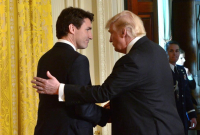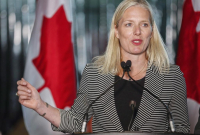Support strong Canadian climate journalism for 2025
The Trudeau government committed Wednesday to spend $62 billion more over the next two decades for a major expansion of the Canadian Armed Forces, aimed at ensuring it can properly defend the country in an increasingly unstable world.
But much of the money won't flow until after the next election, and Defence Minister Harjit Sajjan refused to entertain the question of whether the spending spike would mean bigger federal deficits or spending cuts in other areas.
The promised new cash is the cornerstone of the government's long-awaited defence policy update, which Sajjan unveiled to much fanfare at the Cartier Square Drill Hall in Ottawa.
"If we're serious about our role in the world, we must be serious about funding our military," he told a news conference attended by dozens of uniformed military personnel.
"And we are."
That cash will be essential for the ambitious, 20-year vision laid out in the new policy document, which includes old standbys such as working with the U.S. to defend North America, saving Canadians in distress and working with NATO allies to confront threats abroad.
But the plan also calls for adding various military capabilities, such as the ability to conduct offensive cyberattacks, the purchase of armed drones and the addition of 5,000 more full- and part-time troops.
At the same time, the review also acknowledged significant shortfalls to date in terms of supporting ill and injured soldiers, as well as the amount of money that has already been set aside for major procurement projects.
For example, while the previous government planned to spend $26 billion to replace Canada's 15 frigates and destroyers, the actual cost will be closer to $60 billion, the review says.
Underpinning everything is the reality — spelled out in a major policy speech Tuesday by Foreign Affairs Minister Chrystia Freeland — that Canada can no longer rely on the U.S. for its defence to the same extent it has in the past.
While some of the new money will start flowing this year, the taps aren't expected to really open until 2020-21 — well after the next election, and a veritable lifetime in political Ottawa.
Officials speaking on background said the delay was unavoidable because of the amount of time needed to buy new warships, fighter jets and other major equipment.
But it immediately raised concerns among the opposition Conservatives, as well as some defence analysts, about future spending cuts, which is what happened to Canada's last defence policy.
"This is a book of empty promises," said Tory defence critic James Bezan, whose party released a defence policy while in government in 2008 but raided it a few years later to eliminate the deficit.
"All this spending has been punted down the road until we see any increases after the last election. And of course the government can change its mind."
Sajjan shrugged off such concerns, saying the current as well as future governments "owe it" to those in uniform to "fully fund the Canadian Armed Forces on a long-term footing. And that's what we have done."
There were also unanswered questions about where the Liberal government — already staring at a deficit projected at $23 billion for 2016-17 — will actually find the money to make good on its promises.
Officials say the money for the first five years has already been included in the government's current fiscal plan, but that decisions will need to be made over the longer term.
For his part, Sajjan would only say that the Liberals' defence policy had been "rigorously costed" and was "fully funded," before emphasizing what he described as good news for the military.
The plan sparked immediate praise from NATO Secretary General Jens Stoltenberg, who has previously joined U.S. President Donald Trump in calling for all allies to spend more on their militaries.
"This new policy affirms Canada's unwavering commitment to NATO and will ensure Canada has the armed forces and key capabilities that the alliance needs," Stoltenberg said in a statement.
"In these challenging times, Canada's commitment to the alliance is important as we work to keep our nations safe and NATO strong."
The U.S. is "heartened" by the police announcement, Secretary of Defence Jim Mattis said Wednesday, noting it "demonstrates Canadian resolve to build additional military capacity and a more capable fighting force."
"The United States welcomes Canada's marked increase in investment in their military and their continued commitment to a strong defence relationship with the United States and NATO," Mattis said in a statement.
Trump spokesman Michael Short appeared to give the U.S. president credit for the planned spending increases, linking to a media report on Twitter and writing that Trump was "getting results."
But there also wasn't any indication that the government plans to increase defence spending to meet NATO's target of two per cent of GDP, which is what Trump has demanded of alliance members.
The policy document instead says Canada has been under-reporting its defence spending for years by not including the money spent by other departments on such items as peacekeeping and veterans' benefits.
As a result, it says defence spending is actually around 1.19 per cent this fiscal year, which it will increase to 1.4 per cent of GDP by 2026-27.





Comments